Have you ever wondered how to make your emails distinct and easy to notice?
Personalizing newsletters is an effective way to stand out in the flood of emails. The recipient feels like you've sent a message just for them and becomes more engaged with your letter.
Sending personalized emails also helps to improve your open rates and click-through rates. Plus, it can drive traffic to your website and boost your sales.
Here are a few more benefits of personalized emails:
- 71% of consumers say personalized experiences influence their decision to interact with emails (Dynamic Yield)
- 90% of consumers are willing to share personal behavioral data with companies in exchange for a cheaper and easier experience (SmarterHQ)
- 71% of consumers expect companies to deliver personalized interactions, and 76% get frustrated when this doesn't happen (Demandsage)
Keep on reading to learn 8 effective email personalization practices.
8 tips to personalize your email marketing
1. Segment email lists
2. Personalize the subject line
3. Personalize the sender name
4. Provide personalized content
5. Send behavior triggers
6. Create standouts
7. Utilize A/B testing
8. Meet your subscribers' needs
1. Segment email lists
Segmentation is the foundation of successful email personalization. By dividing your email list into smaller, targeted groups (segments), you can craft emails that resonate with each subscriber's interests and needs.
Ask your subscribers relevant questions in sign-up forms and use this valuable information for segmenting. Choose the segmentation criteria that best align with your audience and marketing goals.
Here are some ideas you can segment your clients based on:
- Geography
- Interests in certain products
- Participation in your events
- Content download
- How often do they want to receive your letters
- Position on the customer path
- Time and type of last purchase
- Pages they visit
- The amount of money typically spent on your products
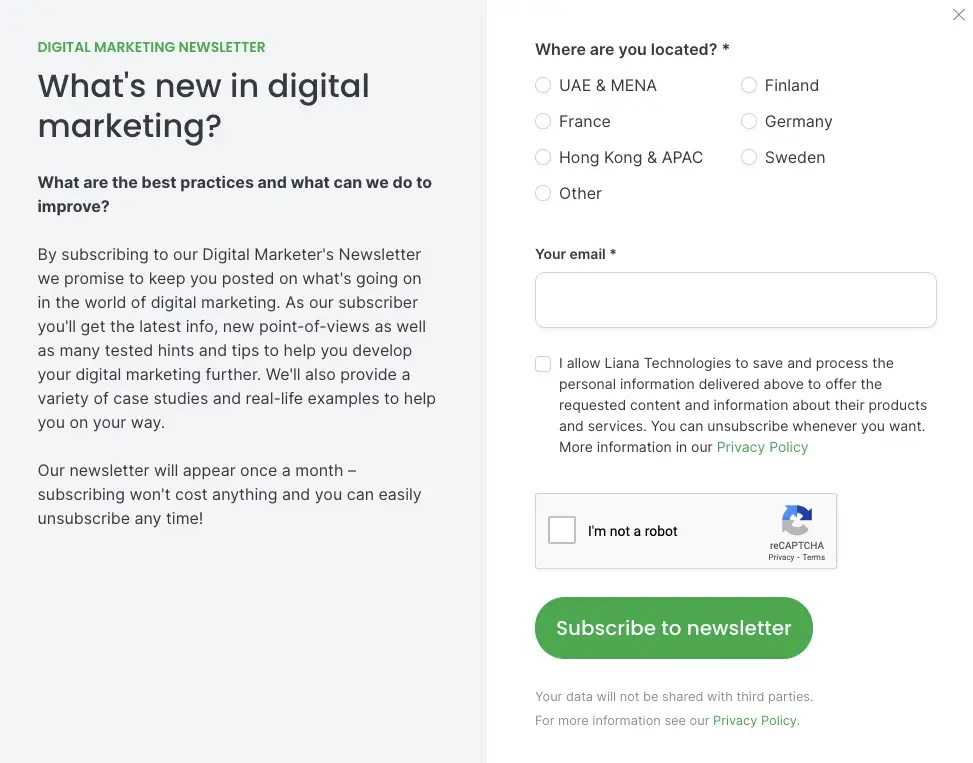
Use your sign-up form also for segmenting purposes. Collect location data to personalize your emails with the right content, language, and timing for each subscriber.
We recommend quality over quantity when segmenting: you can achieve great results with a few well-thought-out segments. It's not data responsible to gather unnecessary data about your subscribers.
2. Personalize the subject line
When thinking about personalized emails, the first thing that typically comes to mind is talking to the recipient with their name. Using the name is an easy way to start personalization, but nowadays, just using the name in the title may not be the only factor that grabs attention.
You can try personalizing the email subject line a bit further:
- Use your subscriber’s location to increase interest in the subject line: “Attention Dubai – our pop-up store opens today!”
- Generate a title based on the recipient’s past behavior: “Enjoy more recipes like the one you loved”
- Write dynamic content based on the recipient's data. "Hurry, Lucy - Your favorite [product category] are back!"
3. Personalize the sender name
While your company name is a safe choice in the 'from' field, consider personalizing it further to add a human touch.
Using a real person’s name is one way to personalize the sender name, but other options exist. You can try these:
- Individual name: "[Your name] from [Company Name]"
- Department name: "[Marketing Team] at [Company Name]"
- Company name with personality: "The Friendly Team at [Company Name]"
Consider your brand image, target audience, tone of voice, and the nature of your newsletter content when choosing the best approach.
4. Provide personalized content
In addition to the subject line, the newsletter content can also be personalized. Delivering content that directly appeals to your recipients' needs and preferences shows you understand them, leading to more engaged subscribers.
Use the segmenting data to come up with the best content personalizations. Personalized newsletter content could include blog articles, tutorials, or product suggestions tailored to the recipient’s interests. They create a more engaging and relevant experience for each subscriber, increasing the likelihood of conversions.
Here are some ideas to try:
- Interesting content: Provide blog articles and other content about a topic the recipient has shown interest in.
- Product recommendations: Recommend products based on past purchases or browsing behavior.
- Location-specific content: Showcase promotions or events relevant to the subscriber's location.
- Personalized offers: Tailor discount codes or special offers based on subscriber preferences.
Discover what features your email marketing solution offers for personalization. For example, with the email marketing tool LianaMailer, you can personalize various parts of your newsletter for individual recipients.
Personalize newsletter content with LianaMailer's personalized block settings
5. Send behavior triggers
Sending emails based on a customer’s action ensures that you keep track of their position on the customer’s journey. Behavior triggers are also a good way to re-engage clients who have fallen off the map.
You can send behavioral emails when, for example:
- You want to welcome a new customer and give them user tips
- A person downloads your content or signs up for your event
- You want to provide the customer with a report of their account activity
- A customer hasn’t used your services for a while
An agile marketing automation platform helps identify customer behavior patterns and deliver the right content on time.
6. Create standouts
Looking for a memorable way to reach out to a customer? Show your clients you know them and make a lasting impression with a creative personalized message. These personalized messages build stronger relationships and can lead to increased engagement and sales.
Standout emails can include special offers or personalized messages that make customers feel valued and appreciated.
Here are some ideas for such emails:
- Send happy customership anniversary greetings to show you value their loyalty
- Make your top clients feel like VIPs by sending them special benefits or early access to new products
- Send birthday greetings with a personalized discount coupon
7. Utilize A/B testing
Try A/B testing to find out which kind of personalized content resonates the most with your audience.
For example, by A/B testing the headline of a newsletter, you can compare the effectiveness of two or more different subject lines. The final newsletter sending will be done with the most successful headline.
A/B testing gives valuable insights to refine personalization strategies and improve overall performance. You can significantly increase open and click rates, and boost the impact of your emails.
8. Meet your subscribers' needs
Some personalization tricks are so subtle that you only notice them when they are done wrong. Respecting the subscriber's characteristics, such as time zone or devices used, you can deliver a more relevant and engaging email experience.
Reach out at the right time
Value your readers’ time: deliver your message when a customer is ready to read it. Make sure you know the best time for your emails to be opened.
Use your email marketing platform's analytics to identify the best sending times for your audience. Consider time zones and cultural holidays as well.
 Try out different timeslots for sending your emails and see what time performs best in terms of open rates. This way, you will find out the best delivery times for your target audience.
Try out different timeslots for sending your emails and see what time performs best in terms of open rates. This way, you will find out the best delivery times for your target audience.
Personalize for different devices
It’s important that your emails are in a format that's easy to read on any device. Ensure your emails are formatted properly and have clear calls to action for smaller screens. Many users check emails on their smartphones, so make it easy for them to take action.
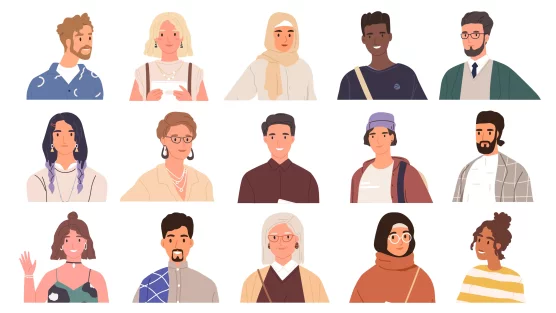
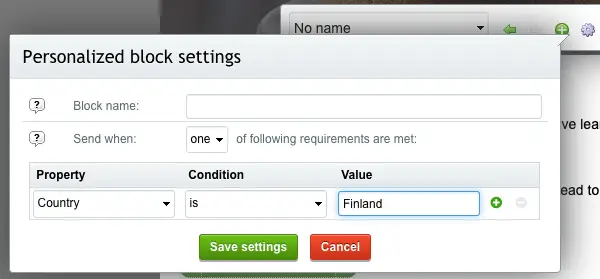
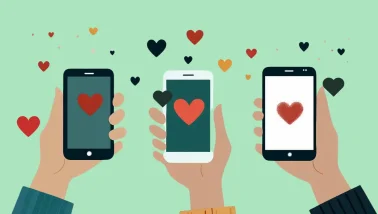
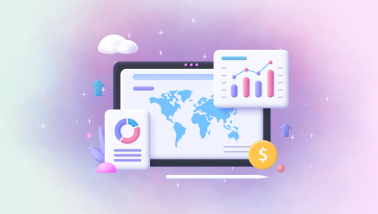
![How to Get Started with Podcasts? [Infographic]](/media/blog/podcast-article/cache/starting-your-own-podcast-article-cover-378x214,c.png)
Comment
Comments
No comments